Horse Chestnut: [Crop, Associations, Pests and Diseases]
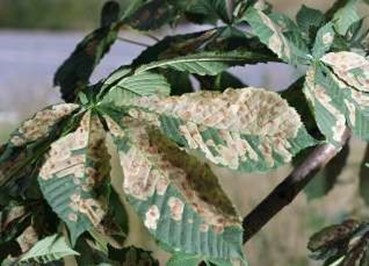
Important points when planting Horse Chestnut
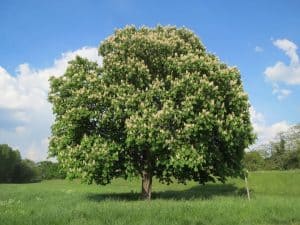 Where to sow? In full light. It needs a lot of sunlight.
Where to sow? In full light. It needs a lot of sunlight.- When? fall or winter.
- How do we prepare the land? Stirred with acid soils. PH of 6-6.5. With universal culture substrate, or one for acidophilic plants.
- How do we water? With drip or sprinkler.
- How often do we water? In summer, 3 to 4 times. The rest of the year 2 to 3 times a week.
- Plagues and diseases? insects Anthracnose, canker and chestnut ink.
The horse chestnut (Aesculus hippocastanum) is a tree that is part of the sapindaceae family and sometimes some specialized books call it «false chestnut».
The reason why this is so, refers above all to the fact that the fruit it bears has a strong external similarity with those produced by trees of the Castanea genus.
It is a majestic tree, up to 25 meters tall, with a rounded crown and large leaves, divided into oval and toothed segments, and flowers grouped in characteristic pyramidal inflorescences.
When to plant a Horse Chestnut?
The horse chestnut should be sown in autumn or winter, when the temperature is low, to promote good germination in spring.
It is an angiosperm species whose flowers begin to appear in spring, around April, and the seeds appear in September. If they fall on the ground they can easily germinate.
Where to plant a Horse Chestnut?
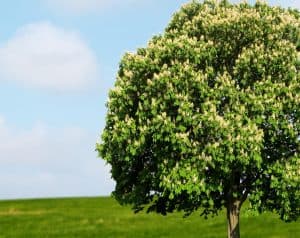 In its native areas it thrives in various habitats including swamps and mixed deciduous forests, and in countries where it has been introduced it is seen mostly in parks and gardens.
In its native areas it thrives in various habitats including swamps and mixed deciduous forests, and in countries where it has been introduced it is seen mostly in parks and gardens.
For the planting of the Horse Chestnut plant, it must be placed outside, since it needs to feel the passing of the seasons.
If possible, it should be in the sun all day, but if you live in the Mediterranean, I advise you to put it in semi-shade (as long as it has more light than shade), as it will grow better.It supports frost down to -17°C, but not temperatures over 35°C.
How to prepare the land?
Horse chestnut can grow in any soil to a maximum altitude of 1485 meters. It prefers acidic soils, with a pH of 6-6.5, and alkaline soils (pH of 7), as long as it has good drainage.
If the climate is mild, with frost and snowfall in winter, the soil can be prepared with a universal growing medium, or one for acidophilic plants. Otherwise, it is recommended to mix 70% akadama with 30% kiryuzuna.
Both are substrates imported from Japan, which are normally used for bonsai, so their price is high, but it is worth placing because it is of good quality and it is special for horse chestnut.
How do we water a Horse Chestnut?
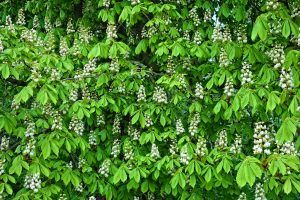 Irrigation for the leafy Horse Chestnut must be frequent, it does not support drought. It is important to carry out drip or sprinkler irrigation, to maintain soil moisture without flooding.
Irrigation for the leafy Horse Chestnut must be frequent, it does not support drought. It is important to carry out drip or sprinkler irrigation, to maintain soil moisture without flooding.
During the summer, it will be necessary to water it 3-4 times a week, especially if you live in a climate with very hot summers.The rest of the year, 2-3 per week will suffice.
The use of rainwater or acidified water is recommended.
How do we plant a Horse Chestnut step by step?
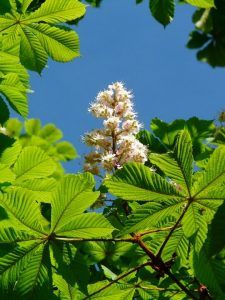 It can be sown by its seeds. In order for them to germinate they need to be cold during the winter months, so if the weather is cool, you can plant them in a pot with universal substrate and let nature take its course.
It can be sown by its seeds. In order for them to germinate they need to be cold during the winter months, so if the weather is cool, you can plant them in a pot with universal substrate and let nature take its course.
Otherwise, it is better and it is recommended to use a container with vermiculite, a little natural fungicide (copper or sulfur), and of course with the seeds to be able to stratify them in the fridge for three months.
You must proceed as follows:
- Fill a container with vermiculite.
- Bury the seeds.
- Sprinkle a little copper or sulfur.
- To water.
- Put the container in the fridge.
- Once a week, open the container so that the air is renewed.
- After three months, the seeds will be sown in pots using, for example, vermiculite.
What favorable associations does it have?
The association of crops of compatible plants produces benefits with respect to their cultivation separately, in addition to the use of light, water and/or nutrients.
However, since horse chestnut is a large bushy type, it is preferable not to associate it with other plants to prevent its development from being affected.
What pests and diseases attack the Horse Chestnut?
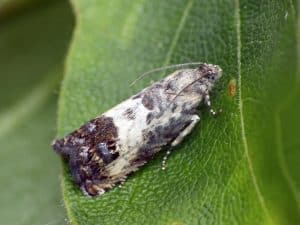 The horse chestnut can be seriously affected by different pests and diseases that reduce its wood production.
The horse chestnut can be seriously affected by different pests and diseases that reduce its wood production.
Most of the pests that affect chestnuts are insects that affect the foliage, the wood, the fruits, and their incidence can be higher or lower depending on the weather and conditions in the area.
pests
Among the pests we can mention:
fascia pammene
This lepidoptera is known as the early chestnut tortricid. In the adult state it can reach a wingspan of 17 mm, it has a vivid coloration with a gray-gray background and a characteristic ivory-colored spot.
Cydia splendana
It is another tortricid lepidoptera that in adulthood can reach a wingspan of 22 mm; the coloration of the typical form is ash gray or gray brown on the forewings.This species can cause significant damage to the already ripe fruits of horse chestnut trees.
Cydia fagiglandana
It is another tortricid lepidoptera that can reach a wingspan of 19 mm in its adult state; the coloration of these individuals is reddish brown or orange and the forewings resemble a fishbone.
Zeuzera Pyrina
This lepidoptera of the cossidae family can reach a wingspan of 70 mm in adulthood, it has a silvery-white coloration with black and metallic blue spots on the wings.
In trees 8 to 10 years old, they can cause branches to break as they are weakened by the galleries that the larvae make in them.
Lymantria dispar
This lepidoptera is also known as the hairy lizard. The females of this species have a large hairy body that can reach 65 mm, with a white coloration and zig-zag spots.
Regarding the control of the aforementioned pests, it can be said that there are no authorized chemical treatments; although there are active ingredients that can give good results and that are being used in other countries.
Diseases
Among the diseases that affect horse chestnut are:
chestnut anthracnose
produced by the fungus Mycosphaerella maculiformis, whose hosts are broadleaves in general and especially oak and chestnut.
chestnut blight
Caused by Cryphonectria parasitica, it was first described in Spain in the 1940s. It is currently the most devastating disease affecting chestnut groves in the Principality of Asturias.
chestnut ink
It is the most important root disease that affects this leafy plant. The symptoms of the disease are: rotting of the root system, yellowing of the leaves, drying of the tips of the branches and abortion of the fruits.
verticillium wilt
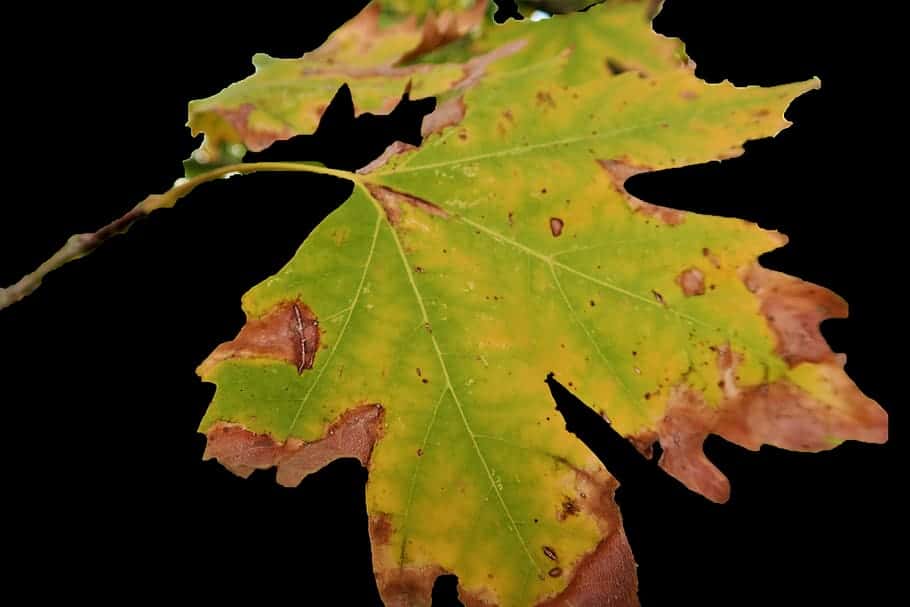 Verticillium or Verticillium wilt is a common soil fungus that thrives in temperate climates around the world and can be present in the soil for decades.
Verticillium or Verticillium wilt is a common soil fungus that thrives in temperate climates around the world and can be present in the soil for decades.
Verticillium wilt overwinters in the soil as dormant mycelium or tiny dormant black structures called microsclerotia, waiting for favorable conditions to return.
They enter damaged plant tissue through the roots and multiply. Many common weeds, such as dandelions and weeds, can be Verticillium host species.
Verticillium wilt is a disease that affects more than 350 species of eudicolous plants. It is caused by six species of Verticillium fungi: Verticillium dahliae, Verticillium albo-atrum, Verticillium longisporum, Verticillium nubilum, Verticillium theobromae, and Verticillium tricorpus.
Many plants with significant economic weight are susceptible, such as cotton, tomatoes, potatoes, oilseed rape, aubergines, peppers, and ornamental plants, as well as others in natural vegetation communities.
Many species and cultivars of eudicots are resistant to the disease, and all monocots, gymnosperms, and ferns are immune. To know more: Verticillium wilt in the Orchard: What is it? How do we identify it?
How long does horse chestnut live?
The normal thing is that it lives an average of 200 years. However, there are records of trees that have reached 2000 years.
How long does it take to grow horse chestnut?
It grows slowly, but surely. You may need up to 20 years to reach adulthood.
How long does it take to produce fruit?
This is a species that takes its time to generate positive results after planting. It may flower after 10 years of planting.
There have even been cases that occupy up to 15 years without producing flowers and, therefore, no fruits.
Can it be grown in a pot?
It is not a species to be worked in pots.
It is possible to keep it in one while it is young, but sooner or later it will be essential to transplant it into the garden.
How many times does horse chestnut produce fruit?
Generates an annual production.
Should the horse chestnut be pollinated to obtain fruit?
The support of bees is needed for the pollination process to occur properly.
This includes the transfer of pollen from one tree to another, as it is incompatible with its own flowers.
How cold can horse chestnut tree tolerate?
It does well in the cold. As an established adult it can tolerate down to -17°C.
How many horse chestnut trees can be planted per hectare?
It is possible to work with 200 horse chestnut specimens per hectare.
What kind of fertilizer does horse chestnut need?
It is recommended to use a balanced NPK fertilizer at a rate of 20-20-20. This must be soluble in water and administered during the spring and summer.
How much heat and/or drought can horse chestnut tolerate?
You have to be careful with excessively hot summers because they are not good for you. More than 35° C will be harmful.
And nothing about drought. It does very poorly when it doesn’t get the proper watering to hydrate it.
Bibliography and references
- Villalva Quintana, Sonia; Del Estal Padillo, Pedro. (2005). Horse chestnut miner. Cameraria ohridella Deschka & Dimic, 1986 (Lepidoptera: Gracillariidae). Terralia. Madrid Spain.
- Morcillo San Juan, Antonio. (2015). Pocket guide to the trees of Madrid. The 50 most common trees in our parks and streets. Mundi-Press Books. Madrid Spain.
- Ara Roldán, Alfredo. (1997). 100 selected medicinal plants. A Guide to Plants from Around the World Selected for Their Therapeutic Value. Publisher Edaf. Madrid Spain.
- Fonnegra G., Ramiro; Jiménez R., Silvia Luz. (2007). Medicinal plants approved in Colombia. Editorial University of Antioquia. Medellin Colombia.
- Sanchez de Membiela, Maria Teresa. (2012). Phytotherapy for the treatment of chronic venous insufficiency. The horse chestnut. Complutense University of Madrid. International Journal of Podiatric Sciences. Madrid Spain. Reproduced from: https://revistas.ucm.es/index.php/RICP/article/download/37905/36671/0

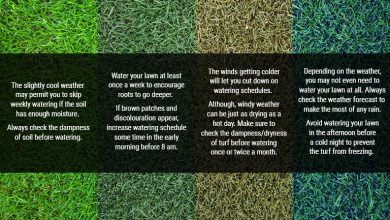
![Photo of Corn Piral (Ostrinia nubilalis): [Characteristics, Detection, Effects and Treatment]](https://www.complete-gardening.com/wp-content/uploads/2021/06/Que-es-el-piral-del-maiz-scaled-1-390x220.jpg)
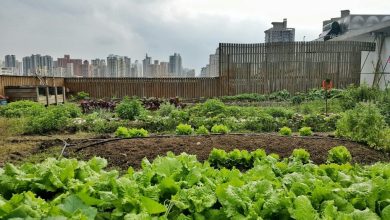
![Photo of Daisies Care: [Soil, Humidity, Pruning and Problems]](https://www.complete-gardening.com/wp-content/uploads/2022/08/daisies-care-soil-humidity-pruning-and-problems-390x220.jpg)